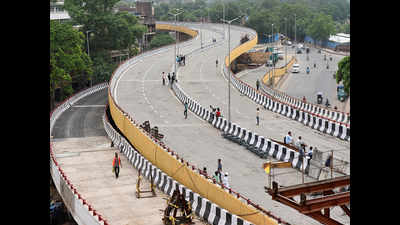- News
- City News
- delhi News
- Just 10 months after opening, Rani Jhansi flyover is already stretched
Trending
This story is from August 11, 2019
Just 10 months after opening, Rani Jhansi flyover is already stretched

Rani Jhansi Flyover
NEW DELHI: Opened after a frustratingly long construction period, the Rani Jhansi flyover is already showing signs of being stretched beyond its capacity. A traffic flow study conducted by North Delhi Municipal Corporation with Delhi Technological University shows that peak hour traffic on most segments of the grade separator is either at the designed volume or already much above it a mere 10 months after its opening. Anticipating a big increase in the use of the flyover, the study recommends a host of measures, including a road safety audit.

The largest chunk of traffic moves between DCM Chowk and Barf Khana rotary.While this segment was meant to handle 3,600 PCU (passenger car units) per hour coming from the direction of Filmistan, the study noted the volume there at 4,000 PCU. In the opposite direction, over 3,800 PCU were using it. A major choke point while heading to St Stephen’s Hospital is the DCM Chowk-Filmistan segment which gets 3,024 PCU per hour against the designed 2,400.
The only section handling less traffic than planned for is Barf Khana-St Stephen’s Hospital, where just 1,353 of the planned 2,400 PCU were on the road every hour.
North corporation officials disclosed that PWD will be approached to kick-start long-term and short-term decongestion measures approved by UTTIPEC last September. For the long term, PWD has been asked to develop an elevated road from Tis Hazari to Azadpur Mandi. But this project may take some time. “PWD hasn’t even accomplished the short-term goals,” another official remarked.
To decongest traffic, UTTIPEC had, in the short term, recommended the closure of two median cuts on Lala Hardev Sahai Marg, at Mori Gate and Rajpur Road junction, to ease movement from Kashmiri Gate junction to the northern toe of Rani Jhansi flyover. It also asked for the creation of a U-turn below Rani Jhansi flyover and back-to-back U-turns near the junction of Court Road.
The transportation infrastructure body also advised the removal of all rotaries and their conversion to signalised junctions on the stretch from the southern toe of the flyover to the Panchkuian T-junction. It also wanted the closure of the median cuts at Idgah Junction and Ram Kumar Marg and one-way movement on Faiz Road between New Rohtak Road and Rani Jhansi Road.
When contacted on the reason for the delay in implementing these short-term measures, the PWD engineer in chief declined a comment.
Professor Sewa Ram, urban mobility expert at the School of Planning and Architecture, noted that most flyovers in the city had already exhausted the designed capacity for traffic volume and urban planners should start thinking of new solutions. Suggesting two steps to augment the capacity of the infrastructure, he said, “Steps should be taken to discourage use of private vehicles through transportation management solutions and interventions like congestion fees. Also, two-tier roads and flyover can be considered, the two levels segregating short-distance traffic from long-distance traffic.”

The largest chunk of traffic moves between DCM Chowk and Barf Khana rotary.While this segment was meant to handle 3,600 PCU (passenger car units) per hour coming from the direction of Filmistan, the study noted the volume there at 4,000 PCU. In the opposite direction, over 3,800 PCU were using it. A major choke point while heading to St Stephen’s Hospital is the DCM Chowk-Filmistan segment which gets 3,024 PCU per hour against the designed 2,400.
The only section handling less traffic than planned for is Barf Khana-St Stephen’s Hospital, where just 1,353 of the planned 2,400 PCU were on the road every hour.
The study has recommended enforcement of uniform speed limits throughout the stretch. It also wants the right turn at the Tis Hazari intersection to be closed. TOI’s visit to the site confirmed that the end near Tis Hazari had indeed become a bottleneck and traffic descending from the flyover got clogged there.
North corporation officials disclosed that PWD will be approached to kick-start long-term and short-term decongestion measures approved by UTTIPEC last September. For the long term, PWD has been asked to develop an elevated road from Tis Hazari to Azadpur Mandi. But this project may take some time. “PWD hasn’t even accomplished the short-term goals,” another official remarked.
To decongest traffic, UTTIPEC had, in the short term, recommended the closure of two median cuts on Lala Hardev Sahai Marg, at Mori Gate and Rajpur Road junction, to ease movement from Kashmiri Gate junction to the northern toe of Rani Jhansi flyover. It also asked for the creation of a U-turn below Rani Jhansi flyover and back-to-back U-turns near the junction of Court Road.
The transportation infrastructure body also advised the removal of all rotaries and their conversion to signalised junctions on the stretch from the southern toe of the flyover to the Panchkuian T-junction. It also wanted the closure of the median cuts at Idgah Junction and Ram Kumar Marg and one-way movement on Faiz Road between New Rohtak Road and Rani Jhansi Road.
When contacted on the reason for the delay in implementing these short-term measures, the PWD engineer in chief declined a comment.
Professor Sewa Ram, urban mobility expert at the School of Planning and Architecture, noted that most flyovers in the city had already exhausted the designed capacity for traffic volume and urban planners should start thinking of new solutions. Suggesting two steps to augment the capacity of the infrastructure, he said, “Steps should be taken to discourage use of private vehicles through transportation management solutions and interventions like congestion fees. Also, two-tier roads and flyover can be considered, the two levels segregating short-distance traffic from long-distance traffic.”
End of Article
FOLLOW US ON SOCIAL MEDIA










